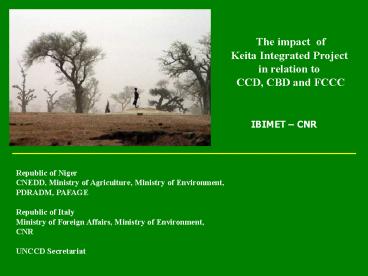IBIMET CNR - PowerPoint PPT Presentation
1 / 8
Title:
IBIMET CNR
Description:
The banquette have transformed. the plateau, from a ... The banquette de glacis have been ... in 1996, especially on the banquette de plateau with more than ... – PowerPoint PPT presentation
Number of Views:22
Avg rating:3.0/5.0
Title: IBIMET CNR
1
IBIMET CNR
The impact of Keita Integrated Project in
relation to CCD, CBD and FCCC
Republic of Niger CNEDD, Ministry of Agriculture,
Ministry of Environment, PDRADM, PAFAGE
Republic of Italy Ministry of Foreign Affairs,
Ministry of Environment, CNR UNCCD Secretariat
2
The 18 million trees planted together with the
watershed approach and the erosion control
interventions lead the project, designed to
reduce food insecurity, to have also a relevant
impact in terms of CCD, CBD and FCCC.
The banquette have transformed the plateau,
from a marginal pasture land to a main resource
with great economic potential Water erosion
control starts from the plateau greatly
contributing in reducing flow in the koris
3
The tranchée have proven extremely efficient in
- eliminating, or at least reducing to a minimum
the water erosion on arable lands in the valley
- making productive previously
- abandoned lands
The banquette de glacis have been effective in
- reclaiming arable land in the valley that have
been subject to desertification and abandoned as
a consequence of the excessive human exploitation
- increase of rain infiltration and soil humidity
compared to similar untreated areas
4
Based on the 1996 data a preliminary study has
been launched in 2002 to assess the impact of
the Keita integrated project in relationto the
FCCC.At the same time the previous results in
relation to CBD and CCD were updated.
In 1996 a research project (PEICRE) has
evaluated the achievements of the Keita
integrated project in terms of land recovery
and desertification reduction. All
interventions realized until then were
registered and data on trees, forage, food crops
and soil were collected.
The preliminary results have been very
encouraging, opening the road for a full-scale
scientific evaluation and providing important
elements for the implementing mechanisms of these
conventions.
5
In relation to the CCD the Keita Integrated
Project represents a major achievement having
shown that desertification can be reversed even
though it demands a long-term engagement.
The Keita case shows that while desertification
is a very rapid process once that the
irreversible threshold has been surpassed,
recovering from it, is a long process demanding
twice the time. In fact only those areas with
extensive interventions dating at least seven
years were showing changes also in the non
treated parts
Aside of the land directly recovered the main
result has been the overall reduction of
vulnerability. The Keita area would now better
respond to a drought both in terms of cereal
and biomass production and productive land lost
to desertification.
The 1996 data shows that already the Keita
Arrondissement was globally reaching a new
environmental equilibrium, reversing the trend
toward degradation and desertification
6
In relation to CBD data collected in 1996,
especially on the banquette de plateau with more
than ten years, have shown an increase in species
diversity and in particular the presence of more
valuable species for grazing that have been
disappeared from the Keita region.
Reports from peasants have proved that the
presence of windbreaks, river edge reforestation
and tree plantation, near the villages has
contributed to attracting disappeared crops
enemies ( rats and birds) and also wild fauna,
thereby increasing the biological diversity and
conservation value.
7
- An evaluation of the Keita Integrated Project
contribution to the Framework Convention on
Climate Change (FCCC) in terms of carbon
sequestration shows some interesting results.
Based on data collected in 1996 and current
literature assumptions the total wood production
(above and below ground) of Keita Integrated
Project has been calculated to be 479,000 tons,
over the period 1990-2000.
During year 2000 the Keita Integrated Project
sequestered approx. 36,000 tons per year of
atmospheric carbon equivalent to 132,000 tons of
CO2
Assuming then that approximately 45 of the
woody biomass of tree species is made of
carbon, the total amount of carbon sequestered
in the period is 216,000 tons, equivalent to
791,000 tons of CO2 sequestered in ten years.
This amount represents about the 37 of the
total carbon quota for Italy allowed in the
Clean Development Mechanism by the
reforestation trading mechanism.
8
Conclusions
The yearly value of the CO2 produced by the Keita
reforestation and afforestation interventions,
using the average value of 10 US/T CO2, is 1.3
million US. While the total value for the ten
years period is 7.9 million US.
The various evaluations of the Keita
Integrated Project, performed in all these
years never have taken into consideration such
source of revenue due to a service provided
by the Keita people. If considered it would
strongly reinforce the sustainability analysis.
Furthermore this economic resource demands a
special and newly designed interaction mechanism
between the local people, those called to manage
the resource, and the national and international
interest.
To be able to exploit this resource it is
necessary to develop standard and procedure
to certify the CO2 quantity. By this end Keita
site could play an important role being one of
the very few sites with such long log of data.
Finally Keita proved that the three conventions
are intimately related as the local people have
always recognized trough their holistic view of
their world.































